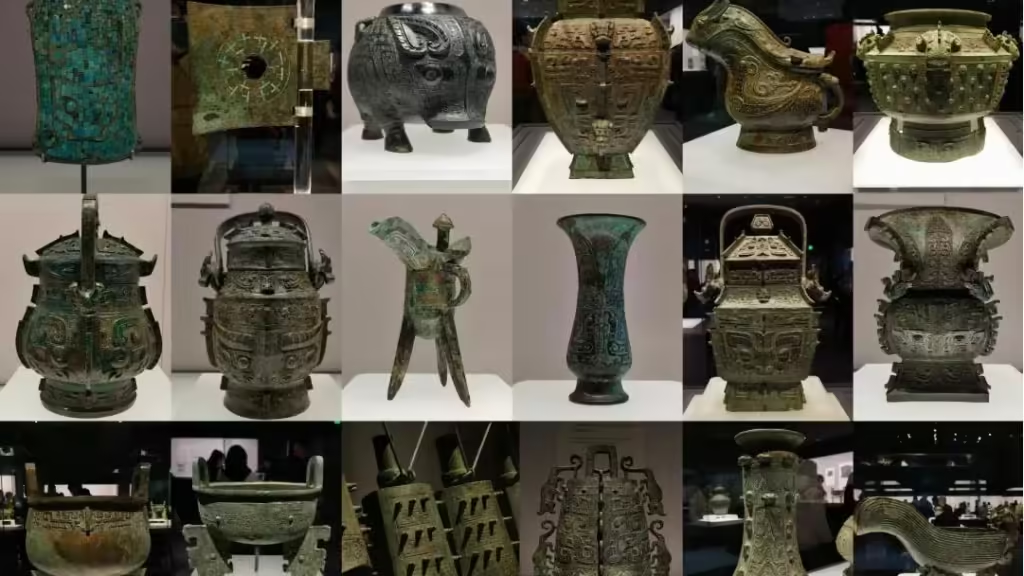The Shanghai Museum, a premier cultural institution in China, houses an impressive collection of artifacts that showcase the rich history and artistry of Chinese civilization. Among its vast array of exhibits, ten treasures stand out as significant national relics, each with its own unique story and cultural importance. These masterpieces, concentrated in the East Wing of the museum, offer visitors a glimpse into ancient China’s craftsmanship and spiritual beliefs. This guide highlights these ten treasures, providing insights into their history and significance.
Da Ke Ding (大克鼎)
- Period: Western Zhou Dynasty (Mid to Late)
- Location: Bronze Gallery, First Floor
- Description: This bronze vessel was cast by a noble named Ke to honor his grandfather. Its inscriptions detail how Ke was appointed and rewarded by the Zhou king for his ancestors’ contributions. Notably, it is one of the 195 artifacts prohibited from being exhibited abroad. The vessel’s legend was brought to life by Yi Yang Qian Xi in the program “National Treasure.”
Xi Zun (牺尊)
- Period: Late Spring and Autumn Period
- Location: Bronze Gallery, First Floor
- Description: Shaped like an ox, this vessel features a bowl on its back for holding wine, exemplifying the ceremonial practices of the time.
Shang Yang Fang Sheng (商鞅方升)
- Period: Warring States Period
- Location: Bronze Gallery, First Floor
- Description: This standard measuring device was created by Shang Yang during his reforms in the Qin state. Like Da Ke Ding, it is also one of the artifacts restricted from international exhibition. Huang Lei has played a role in protecting this significant item on “National Treasure.”
White Stone Bodhisattva Statue (白石供养菩萨像)
- Period: Tang Dynasty
- Location: Sculpture Gallery, First Floor
- Description: Carved from white marble, this statue originates from Chang’an during the reign of Emperor Xuanzong and is a testament to Tang artistry and religious devotion.
Shijiahe Culture Jade Deity (石家河文化玉神人)
- Period: Late Neolithic
- Location: Jade Gallery, Second Floor
- Description: This rare full-body jade figure from the Shijiahe culture is notable for its intricacy and craftsmanship, reflecting the artistic standards of its time.

King of Di (晋归义氐王)
- Period: Western Jin Dynasty
- Location: Seal Carving Gallery, Second Floor
- Description: This official seal was issued by the Western Jin Dynasty to a leader of the Di ethnic group, serving as an important symbol of authority and governance.
Ruyao Celadon Plate (汝窑青釉盘)
- Period: Northern Song Dynasty
- Location: Ceramics Gallery, Third Floor
- Description: As a representative piece of Ru kiln ceramics, this celadon plate exemplifies the delicate beauty and craftsmanship of Song Dynasty pottery.
Jingdezhen Kiln Pink-Glazed Bat and Peach Pattern Vase (景德镇窑粉彩蝠桃纹瓶)
- Period: Qing Dynasty, Yongzheng Period
- Location: Ceramics Gallery, Third Floor
- Description: This vase is the only surviving example of its kind in the category of pink-glazed porcelain, showcasing the intricate designs typical of the Jingdezhen kiln.
Sun Wei’s “High Spirits” Scroll (孙位 高逸图卷)
- Period: Tang Dynasty
- Location: Painting Gallery, Second Floor (Not Currently Open)
- Description: This unique work by the famous Tang court painter Sun Wei is a surviving fragment of the “Seven Sages of the Bamboo Grove” scroll. It is also part of the restricted artifacts.
Huaisu’s “Cursive Script on Bitter Bamboo Shoots” Scroll (怀素 草书苦笋帖卷)
- Period: Tang Dynasty
- Location: Calligraphy Gallery, Second Floor (Not Currently Open)
- Description: This scroll is the only undisputed authentic work by Huaisu, recognized for its connection to Buddhist calligraphy and tea culture. It is yet another of the 195 artifacts not allowed to leave the country.

